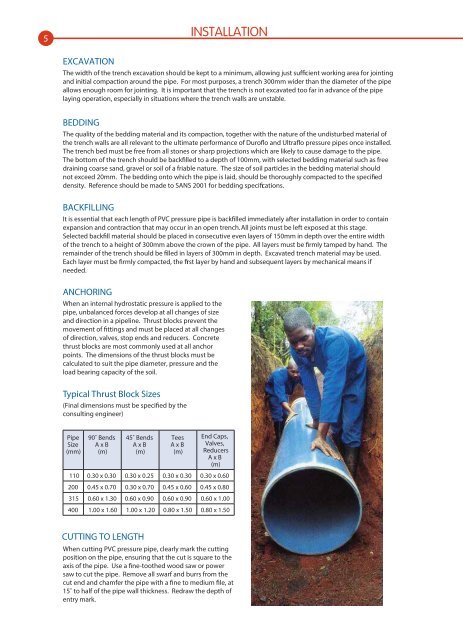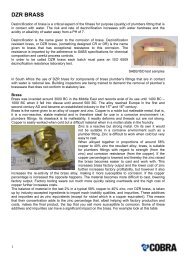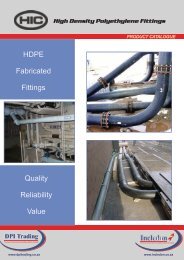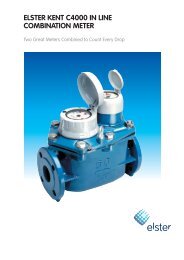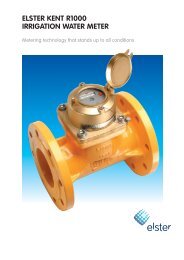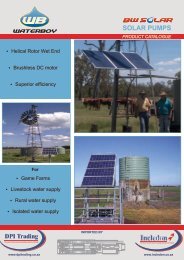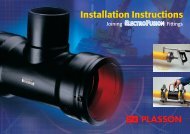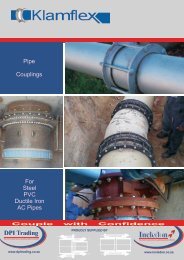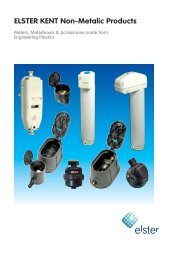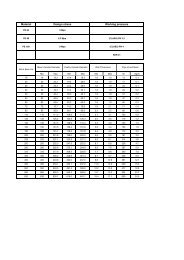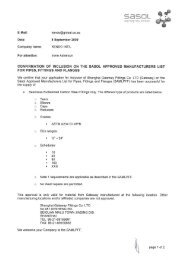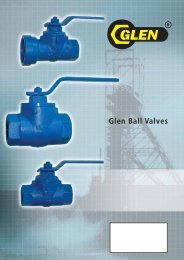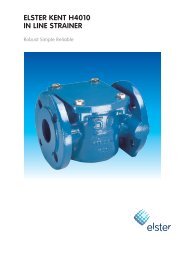DPI Plastics Pressure Catalogue - Incledon
DPI Plastics Pressure Catalogue - Incledon
DPI Plastics Pressure Catalogue - Incledon
Create successful ePaper yourself
Turn your PDF publications into a flip-book with our unique Google optimized e-Paper software.
5<br />
INSTALLATION<br />
EXCAVATION<br />
The width of the trench excavation should be kept to a minimum, allowing just sufficient working area for jointing<br />
and initial compaction around the pipe. For most purposes, a trench 300mm wider than the diameter of the pipe<br />
allows enough room for jointing. It is important that the trench is not excavated too far in advance of the pipe<br />
laying operation, especially in situations where the trench walls are unstable.<br />
BEDDING<br />
The quality of the bedding material and its compaction, together with the nature of the undisturbed material of<br />
the trench walls are all relevant to the ultimate performance of Duroflo and Ultraflo pressure pipes once installed.<br />
The trench bed must be free from all stones or sharp projections which are likely to cause damage to the pipe.<br />
The bottom of the trench should be backfilled to a depth of 100mm, with selected bedding material such as free<br />
draining coarse sand, gravel or soil of a friable nature. The size of soil particles in the bedding material should<br />
not exceed 20mm. The bedding onto which the pipe is laid, should be thoroughly compacted to the specified<br />
density. Reference should be made to SANS 2001 for bedding specifications.<br />
BACKFILLING<br />
It is essential that each length of PVC pressure pipe is backfilled immediately after installation in order to contain<br />
expansion and contraction that may occur in an open trench. All joints must be left exposed at this stage.<br />
Selected backfill material should be placed in consecutive even Comparitive layers of 150mm Assembly in depth over Forces the entire width<br />
of the trench to a height of 300mm above the crown of the pipe. All layers must be firmly tamped by hand. The<br />
remainder of the trench should be filled in layers of 300mm in depth. Excavated trench material may be used.<br />
Each layer must be firmly compacted, the first layer by hand and subsequent layers by mechanical means if<br />
needed.<br />
ANCHORING<br />
When an internal hydrostatic pressure is applied to the<br />
pipe, unbalanced forces develop at all changes of size<br />
and direction in a pipeline. Thrust blocks prevent the<br />
movement of fittings and must be placed at all changes<br />
of direction, valves, stop ends and reducers. Concrete<br />
thrust blocks are most commonly used at all anchor<br />
points. The dimensions of the thrust blocks must be<br />
calculated to suit the pipe diameter, pressure and the<br />
load bearing capacity of the soil.<br />
Typical Thrust Block Sizes<br />
(Final dimensions must be specified by the<br />
consulting engineer)<br />
Pipe<br />
Size<br />
(mm)<br />
90˚ Bends<br />
A x B<br />
(m)<br />
45˚ Bends<br />
A x B<br />
(m)<br />
Tees<br />
A x B<br />
(m)<br />
End Caps,<br />
Valves,<br />
Reducers<br />
A x B<br />
(m)<br />
110 0.30 x 0.30 0.30 x 0.25 0.30 x 0.30 0.30 x 0.60<br />
200 0.45 x 0.70 0.30 x 0.70 0.45 x 0.60 0.45 x 0.80<br />
315 0.60 x 1.30 0.60 x 0.90 0.60 x 0.90 0.60 x 1.00<br />
400 1.00 x 1.60 1.00 x 1.20 0.80 x 1.50 0.80 x 1.50<br />
CUTTING TO LENGTH<br />
When cutting PVC pressure pipe, clearly mark the cutting<br />
position on the pipe, ensuring that the cut is square to the<br />
axis of the pipe. Use a fine-toothed wood saw or power<br />
saw to cut the pipe. Remove all swarf and burrs from the<br />
cut end and chamfer the pipe with a fine to medium file, at<br />
15˚ to half of the pipe wall thickness. Redraw the depth of<br />
entry mark.


